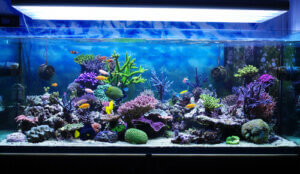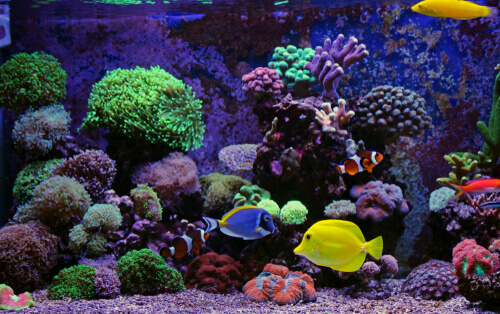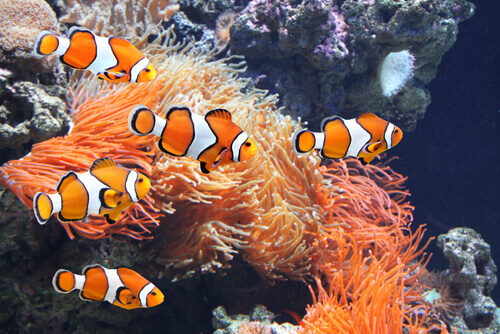How to Care For Your Marine Aquarium


Written and verified by the biologist Ana Díaz Maqueda
Having a marine aquarium at home may not be one of the cheapest hobbies around. In fact, both its assembly and maintenance require time and money. However, there are ways to save, as maintaining a smaller tank is much less expensive than maintaining a gigantic one.
What you should never forget is that you are dealing with living beings, whose well-being depends entirely on you. For this reason, it’s essential that you know full well what it means to have a marine aquarium at home. In addition, you should think about the responsibility it entails.
A piece of sea in your home
Today, many of the fish and other animals you can buy for your marine aquarium come from hatcheries. However, at the same time, others come directly from the ocean, something we should all reject.
The extraction of species from their natural environment is never justifiable except for scientific or conservation purposes.
In any case, a saltwater aquarium must perfectly imitate the habitat of these animals, which means recreating their environmental conditions. Do you know the needs of the inhabitants of a marine aquarium? Here we’ll tell you what you need to know.
Necessary equipment for a marine aquarium at home
The equipment you’ll need to start a marine aquarium is somewhat more complex and advanced than that of a freshwater tank. Here’s a list of the basic equipment that the marine aquarium will require:
- A glass or acrylic tank. The bigger it is, the easier it will be to maintain. It can’t be less than 20 gallons.
- Special salt for marine aquariums and a tank for dissolving.
- A Filter. There are many types: Sponge, trickle, canister, undergravel, and airlift filters, to name a few.
- Marine gravel or sand.
- Living rock that acts as a superior biological filter. It provides bacteria and microorganisms essential for life in the aquarium. It also regulates the pH, besides being a good shelter.
- Thermometer to control the water temperature.
- Hydrometer to measure the density of the water, and the amount of salt in this case.
- Water heater to raise the temperature if necessary.
- Siphon to clean gravel or sand, to keep the substrate clean.
- Test kits for water. There are various gauges to control parameters such as pH and various dissolved substances.
- Algae scraper or magnetic glass cleaner to eliminate the proliferation of algae that adhere to the walls of the tank.
So far, we’ve named the essential equipment to keep a marine aquarium at home. In addition, the following equipment will make the care of the aquarium much easier. What’s more, your fish will be healthier and less likely to get sick:
- Skimmer or protein separator. This device serves to create a foamy water current typical of natural marine ecosystems. It also acts as a powerful filter and oxygenator.
- Sterilizing ultraviolet light. Eliminates bacteria, viruses, fungi, and other microorganisms that can damage fish.
- Advanced lighting systems to recreate sunlight, essential if you have live corals.
- Ozonizer. Ozone filter that keeps the water in perfect condition.

The care and maintenance of a saltwater aquarium
Marine fish need a very specific environment to stay healthy. Unfortunately, many of these animals come directly from the sea, so the aquarium must perfectly imitate their environment if they are to survive. To do this, the marine aquarium in your home must meet the following requirements:
- You must make sure that the temperature of your aquarium is kept between 73 and 82 degrees Fahrenheit. This range makes the fish thrive; otherwise, they could become sick or weak.
- The water, obviously, must be salty. You do this by mixing salt for marine aquariums with fresh water. It’s essential to know the salinity of the water in which the fish you want to introduce usually live. However, you’ll usually need to add 1 tablespoon of salt for every three gallons of water. Before introducing the fish, make sure that the density of the water is 1 026.
- Check the pH of the water. Doing so will tell you if the environment is too acidic or basic for the animals and plants in the marine aquarium. In the case of saltwater aquariums, the optimum pH is basic, around 8.2.
Cleaning a marine aquarium
Another thing you should do to keep your marine aquarium healthy is routine cleaning. Even if you have all the equipment available on the market, cleaning the tank is essential. However, the more advanced the equipment is, the less cleaning sessions you’ll have to do.
To begin with, you should change the water every two weeks, approximately. This involves removing ten percent of the water and replacing it with new water when the rest of the elements are clean.
Then, remove all the decorative objects and wash them in a sink with a brush, without using soap. Remove the algae from the walls and, finally, clean the substrate with the help of the gravel cleaner siphon.

As with any other pet, you’ll need to invest time and care into maintaining your marine aquarium and keeping your fish healthy. But, in the end, being able to observe your magnificent, healthy, and clean marine aquarium will bring you much joy, calm, and tranquility.
All cited sources were thoroughly reviewed by our team to ensure their quality, reliability, currency, and validity. The bibliography of this article was considered reliable and of academic or scientific accuracy.
- de Guevara Malibe, S. M. L. (1994). Un acuario marino; su formación y mantenimiento.
- González Hernández, J. H., Pineda Mercado, R., & Romero Mendoza, O. J. (2020). Sistema de control y monitoreo para acuarios (Aquarium Resort).
- Teton, J. (2003). Guía técnica de la acuariofilia (Vol. 2). Ediciones AKAL.
This text is provided for informational purposes only and does not replace consultation with a professional. If in doubt, consult your specialist.